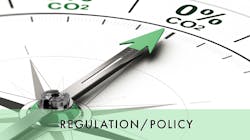POLICY | Decarbonization introduces economic prospects for lighting and building industry
The summer of 2023 was the hottest on record, according to the European Union Climate Change Service, and it coincided with extreme weather events around the world that have escalated in severity over the past three decades. To combat climate change, nearly 200 countries plus the European Union signed the 2015 Paris Agreement, which called for limiting global warming to an increase of 1.5°C above pre-industrial levels. This would require carbon emissions to be roughly halved by 2023 and reach net zero by 2050.
In the United States, the Biden administration has made carbon reduction a national priority. In 2021, it set a goal to cut carbon emissions by at least one-half from a 2005 baseline by 2030. This is reflected in the Inflation Reduction Act of 2022, which arguably includes the largest climate legislation in American history. The administration’s policies include spending focused on renewable energy, building retrofits and efficiency, transportation and building electrification, manufacturing, and land use and resilience.
Buildings represent a significant source of carbon savings as they are responsible for an estimated 39% of global energy-related emissions. According to the World Green Building Council, this is the total of 11% from materials and construction and the remaining 28% from operational emissions (lighting, HVAC, power). Transportation, meanwhile, accounts for about 24%.
In the U.S., some jurisdictions are enacting their own policies. According to energy efficiency consulting firm Vert Energy Group, dozens of municipalities have adopted or are phasing in requirements. Generally speaking, these aim for benchmarking and decarbonization. A prominent example is New York City, where Local Law 97 takes effect in 2024. The law places carbon caps on buildings over 25,000 square feet, imposes a financial cost for exceeding the caps, and accelerates toward a goal of net-zero carbon emissions by 2050. Optimizing energy efficiency can reduce emissions and resulting costs.
Amidst all this, growing demand for plug-in EVs — electric vehicles that produce zero tailpipe emissions — is likely to coincide with significant adoption of charging stations in commercial buildings as the traditional vehicle refueling model may become distributed. A commercial building may add EV charging due to government mandate (as in the case of public buildings) as a potential source of revenue or as an amenity. Various incentives are available, such as government and utility rebates. Concurrently, this electrification is expected to place significant strain on the existing power grid, which may, among other consequences, increase rates and stimulate utilities to commit to incentivizing efficiency more deeply as a lower-cost resource for satisfying power demand. For the building owner, this will impose a cost that may be partially offset by optimizing efficiency.
All of the above is a complex, rapidly evolving puzzle in which lighting and lighting controls are a single piece. Energy-efficient lighting and controls have always delivered value based on local energy costs. That isn’t changing. What’s new is the true value of their energy savings may likely increase in a decarbonizing world, potentially expanding what is considered low-hanging fruit.
Extend the value prospects
If a building owner faces external costs for not optimizing energy efficiency and subsequently accounts for these costs in retrofit investment analysis, the owner may be more amenable to approving upgrade projects. The owner may also favor incorporating detailed lighting control strategies and premium options like networked lighting controls, demonstrated to maximize lighting energy savings and deliver other potential value such as data that transcends a direct return on investment. When all costs and value are present and accounted for, deep retrofits can be attractive, with all options on the table.
Obviously, these economics are applicable in a highly individualized manner by project, but overall, they are expected to stimulate markets for retrofits heading into the future.
In its November 2022 report Retrofitting Buildings to be Future-Fit, commercial real estate services firm Jones Lang LaSalle (JLL) stated that to achieve the goals of the Paris Agreement, the Global North — such as the United States, Canada, and the European Union — will need to triple the rate of building retrofits from barely 1% of the installed building stock to at least 3% per year. JLL added that it is generally in the interest of building owners, when all value is considered, to not only retrofit now but to conduct a deep retrofit.
According to the report, early adopters of net-zero buildings will benefit from greater competitiveness in attracting and retaining high-quality tenants at higher rents, impacting net operating income and offering value beyond direct ROI. The company’s 2022 Future of Work Survey found that three out of four respondents said their organizations would be willing to pay more to lease a building with recognized sustainability credentials. One out of five said they already have. Conversely, inaction may impose on energy-inefficient properties a “brown discount,” or steep value depreciation, as demand for net-zero properties increases.
“Rising energy costs will hasten the move towards efficient buildings and reinforce emerging value trends, with the financial risks of inaction already becoming apparent,” the report stated.
Decarbonization involves maximizing operational efficiencies, electrifying heat, and sourcing off-site local renewable energy and building onsite renewables, with offsetting as a last resort. To maximize success, building owners should take a holistic, long-term approach that supports occupant needs, health, and wellbeing. Retrofitting Buildings to be Future-Fit identified a number of attractive building asset upgrades, including solar roof panels, green spaces, smart glass for daylighting, cycle storage, heat pumps, EV charging, and water harvesting. In terms of the lighting scope, the report specifically called out LED luminaires, detailed deployment of sensors, and digital (networked lighting) controls that generate data that in turn can be leveraged for energy management, reporting, and to optimize occupant comfort.
“The technology, systems, processes, and means to reach net zero carbon and beyond exist today, but there is no one singular strategy, technology, or entity that will address the journey and there is also no one-size-fits-all approach,” the JLL report concluded. “While the scope and complexity of the challenge is immense, retrofitting existing buildings is the quickest and most cost-effective way to accelerate decarbonization in the built environment.”
Conclusions
Lighting and lighting controls have long been a keystone for improving commercial building energy efficiency. The growing urgency for decarbonization is driving policies, costs, and value that are prevailing toward increasing the value of energy savings and building operating data. The resulting economics favors not only saving energy but maximizing energy savings, placing more aggressive energy-saving options on the table such as space-individualized lighting design, networked lighting controls, and plug load control. In some cases, the economics may be such that revisiting existing (particularly older) LED installations and conducting a more robust upgrade as part of a holistic building retrofit can be advantageous as well.
Lighting practitioners are encouraged to keep their ear to the ground about these trends, particularly how they may impact the markets they serve, and tune into opportunities with fresh thinking and broad expertise.
CRAIG DILOUIE, LC, CLCP serves as education director for the Lighting Controls Association, a council of NEMA dedicated to educating the public about lighting controls.
Follow our LinkedIn page for our latest news updates, contributed articles, and commentary, and our Facebook page for events announcements and more. You can also find us on the X platform.

Craig DiLouie
Craig DiLouie, LC, CLCP, is education director for the Lighting Controls Association, a council of the National Electrical Manufacturers Association dedicated to educating the public about lighting control technology and application. Learn more at lightingcontrolsassociation.org.







![The DesignLights Consortium continues to make progress in shifting outdoor lighting products and implementation practices toward a more restrained and thoughtful strategy. [Image does not represent a DLC qualified fixture.] The DesignLights Consortium continues to make progress in shifting outdoor lighting products and implementation practices toward a more restrained and thoughtful strategy. [Image does not represent a DLC qualified fixture.]](https://img.ledsmagazine.com/files/base/ebm/leds/image/2024/08/66be810888ae93f656446f61-dreamstime_m_265700653.png?auto=format,compress&fit=&q=45&h=139&height=139&w=250&width=250)